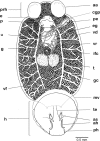The complete mitochondrial genome and description of a new cryptic species of Benedenia Diesing, 1858 (Monogenea: Capsalidae), a major pathogen infecting the yellowtail kingfish Seriola lalandi Valenciennes in the South-East Pacific
- PMID: 31623679
- PMCID: PMC6798380
- DOI: 10.1186/s13071-019-3711-5
The complete mitochondrial genome and description of a new cryptic species of Benedenia Diesing, 1858 (Monogenea: Capsalidae), a major pathogen infecting the yellowtail kingfish Seriola lalandi Valenciennes in the South-East Pacific
Abstract
Background: The monogenean Benedenia seriolae parasitizes fishes belonging to the genus Seriola, represents a species complex, and causes substantial impact on fish welfare in aquaculture systems worldwide. This study reports, for the first time, the complete mitochondrial genome of B. humboldti n. sp., a new cryptic species from the South-East Pacific (SEP).
Methods: The mitogenome of B. humboldti n. sp. was assembled from short Illumina 150 bp pair-end reads. The phylogenetic position of B. humboldti n. sp. among other closely related congeneric and confamiliar capsalids was examined using mitochondrial protein-coding genes (PCGs). Morphology of B. humboldti n. sp. was examined based on fixed and stained specimens.
Results: The AT-rich mitochondrial genome of B. humboldti is 13,455 bp in length and comprises 12 PCGs (atp8 was absent as in other monogenean genomes), 2 ribosomal RNA genes, and 22 transfer RNA genes. All protein-coding, ribosomal RNA, and transfer RNA genes are encoded on the H-strand. The gene order observed in the mitochondrial genome of B. humboldti n. sp. was identical to that of B. seriolae from Japan but different from that of B. seriolae from Australia. The genetic distance between B. humboldti n. sp. and B. seriolae from Japan was high. Minor but reliable differences in the shape of the penis were observed between Benedenia humboldti n. sp. and congeneric species.
Conclusions: Phylogenetic analyses based on PCGs in association with differences in the shape of the penis permitted us to conclude that the material from the South-East Pacific represents a new species of Benedenia infecting S. lalandi off the coast of Chile. The discovery of this parasite represents the first step to improving our understanding of infestation dynamics and to develop control strategies for this pathogen infecting the farmed yellowtail kingfish, Seriola lalandi, in the South-East Pacific.
Keywords: Disease; Flatworm; Fluke; Marine; Purifying selection; Vector.
Conflict of interest statement
The authors declare that they have no competing interests.
Figures









References
-
- Rohde K. Marine parasitology. Collingwood: Csiro Publishing; 2005.
-
- Ernst I, Whittington I, Corneillie S, Talbot C. Monogenean parasites in sea-cage aquaculture. Austasia Aquacult. 2002;16:46–48.
-
- Hutson K, Ernst I, Whittington I. Risk assessment for metazoan parasites of yellowtail kingfish Seriola lalandi (Perciformes: Carangidae) in South Australian sea-cage aquaculture. Aquaculture. 2007;271:85–99. doi: 10.1016/j.aquaculture.2007.03.020. - DOI
-
- Buchmann K, Bresciani J. Monogenea (phylum Platyhelminthes) In: Woo PT, editor. Fish diseases and disorders. Volume 1: Protozoan and metazoan infections. 2. Wallingford: CABI Publishing; 2006. pp. 391–416.
MeSH terms
Substances
Grants and funding
LinkOut - more resources
Full Text Sources

